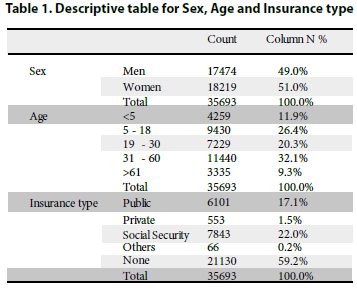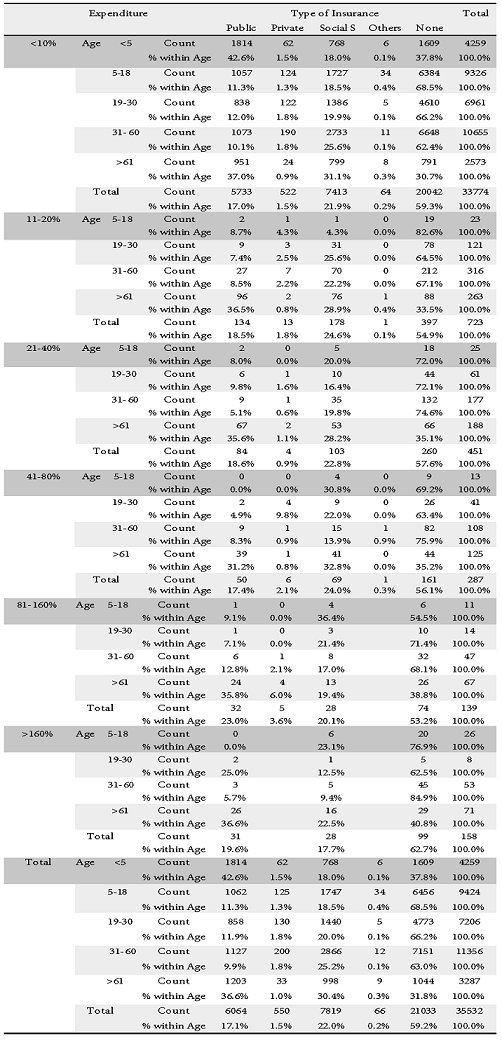Services on Demand
Journal
Article
Indicators
Related links
Share
Gaceta Médica Boliviana
On-line version ISSN 1012-2966
Gac Med Bol vol.42 no.2 Cochabamba Dec. 2019
Cartas al editor
Health Expenditure based on Insurance type and age prior to Implementation of universal health coverage in Bolivia
Gastos de salud según el tipo de seguro y la edad previa a la implementación de la cobertura universal de salud en Bolivia
Juan Pablo Jaldin1, Rodrigo K. Arce Cardozo2, Maria Kezia Lourdes Pormento3
1Physician, San Andres University Medical School.2Physician, NYU Langone Health, NYU School of Medicine, Department of Population Health.3Physician, Ateneo School of Medicine and Public Health.*Correspondencia a: Juan Pablo JaldinCorreo electrónico: dr.jpjaldin@gmail.com
Recibido el 08 de septiembre de 2019.
Aceptado el 28 de septiembre de 2019.
Ms. Editor:
We would like to present a brief study report of the health expenditure based on insurance type and age prior to implementation of universal health coverage in Bolivia. This study will help us to understand better the health expenditure of the Bolivian population continue investigations, and take actions in order to improve the current health system.
Introduction
In February 2019, the Bolivian government approved the universal health coverage with the goal of providing coverage to uninsured population (62,1%). Although there is literature available, which evaluates and describes the health system, there is no information on demographic distribution of improved health care services1.
Assessment on the out of pocket payment amount or the relationship it has with, level of care, considering newly approved health policies like “the familiar, communitarian and intercultural” (SAFCI) program, benefits expansion and creation of elderly government-based insurance, and law 405 of health as a human right2. International organizations have tried to assess the differences in other countries of the region3,4, but this research is presented through cases and fails to assess the health systems as a whole5. It is for this reason that will assess the distribution of health expenditure against health insurance in Bolivia and its relation to all insured and uninsured.
Methods
The Dataset analyzed is granted from the National Institute of Statistic (INE) of the Plurinational Government of Bolivia and public information, it includes the information of 35,693 households. The Bolivian currency was converted into american dollars for the study purposes. The survey was performed from November 21 to December 13, 2013. The methodology of the survey was face to face interview.
Chi-Square was used to see variations between our groups of interest using SPSS. Multivariate analysis evaluating the associations between the insurance type of the persons interviewed and the self-reported percentage of expenses in relation to income provided.
Results
Health expenditure is defined as the percentage of income spent as household. The results show majority of respondents do not have health insurance 59,2% (Table 1), regardless of age, followed by Social Security 22%, Public 17,1%, Private 1,5%, and Others 0,2%. Majority of respondents spent less than 10% of their income on health and came from the 5-18 years old age group. Those who spent >160% had no insurance (Table 2).

Table 2. Cross-tabulation of, Age, Type of Insurance, and Expenditure

Discussion
The data shows the public insurance has some success in mitigating the expenses in people less than 5 and more than 61 years old. This could be due to prevalent diseases according to age in both groups, which can be shown in future research. In other groups the expenses are high even in the insured, especially the social security insurance. This category has shown to have half the expenses when compared to the uninsured group after we adjust for age.
The number of uninsured people remains considerably high and even as the health expenditure of self-reported out of pocket payments is small, this does not take in to account the need of services, the question remaining open if the lower income segments of the population are not being able to afford services they require or need.
Further exploration on the conditionings that shape health are still necessary to draw definitive conclusions.
Keywords: Out of pocket health expenditure, health insurance, health expenditure
Bibliographic references
1. Ledo C, Soria R. Sistema de Salud de Bolivia. (Spanish). Health Syst Boliv Engl. 2011;53:S109-S119.
2. Alvarez FN, Leys M, Mérida HER, Guzmán GE. Primary health care research in Bolivia: systematic review and analysis. Health Policy Plan. May 2015:czv013. doi:10.1093/heapol/czv013.
3. Woodhouse C, Lopez Camelo J, Wehby GL. A Comparative Analysis of Prenatal Care and Fetal Growth in Eight South American Countries. PLoS ONE. 2014;9(3):e91292. doi:10.1371/journal.pone.0091292.
4. Ramírez Hita S. [Intercultural aspects of the health system reform in Bolivia]. Rev Peru Med Exp Salud Pública. 2014;31(4):762-768.
5. WHO Ranking of Health System Performance. Science. 2001;293(5535):1595-1596.














